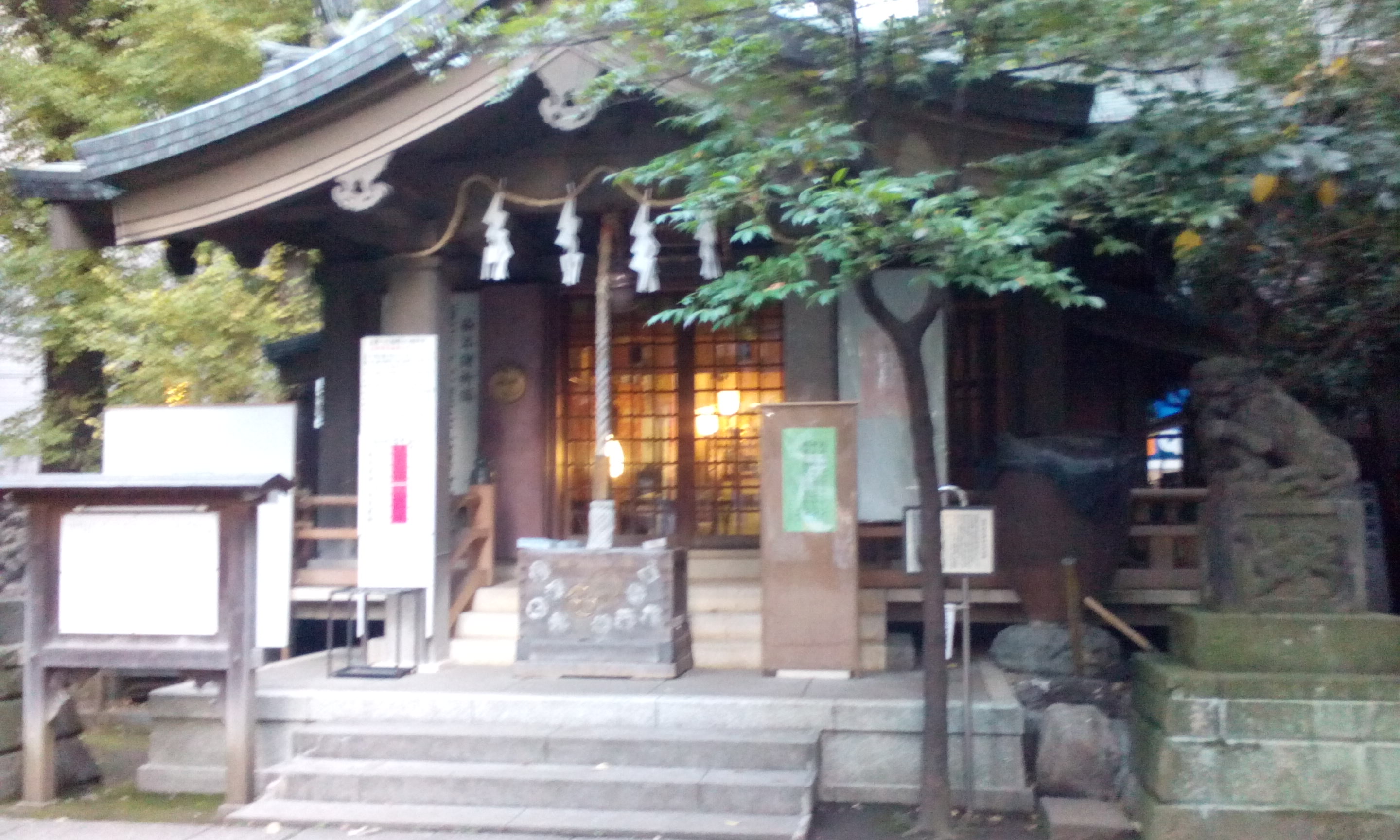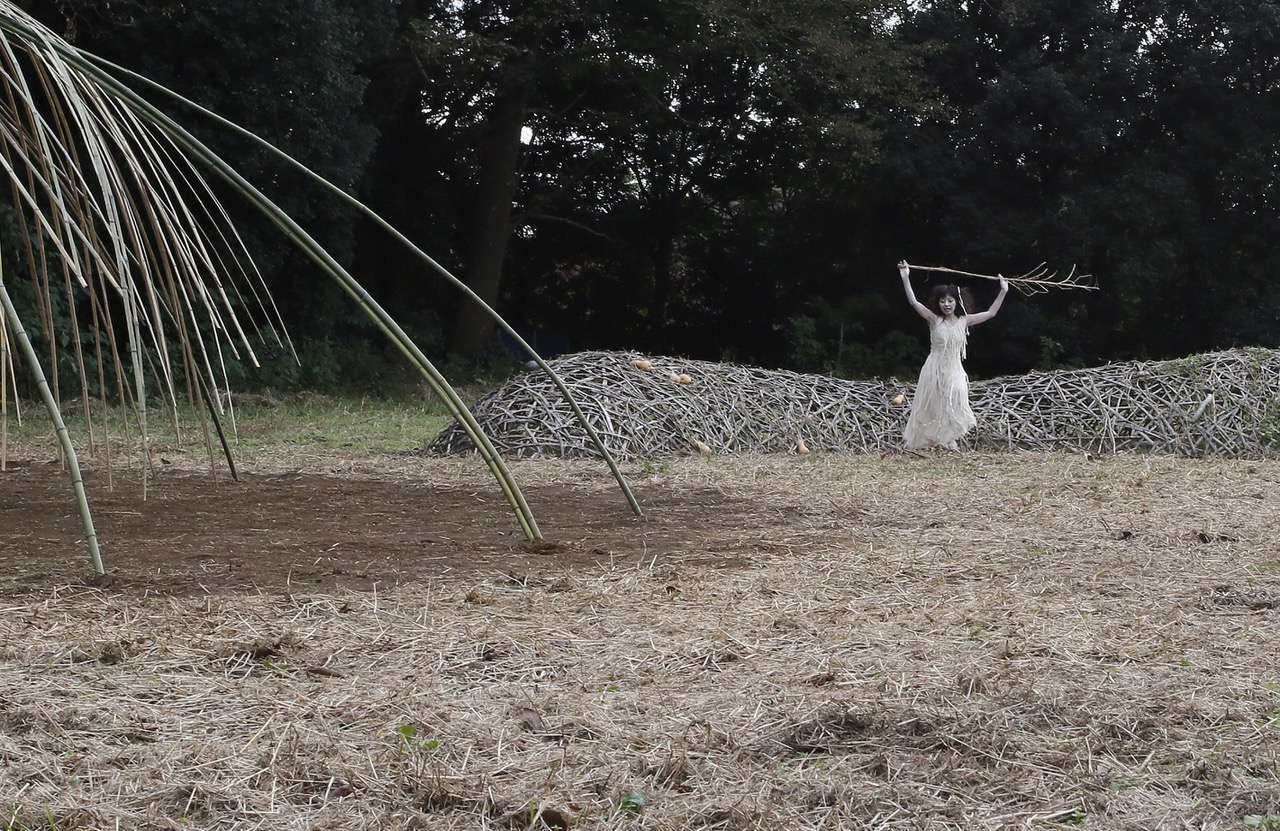Suikinkutsu (2017) - 14’51’’
Audio Live recording
Live performance 8 sine oscillators and field recordings
Audio Live recording
Live performance 8 sine oscillators and field recordings
The Suikinkutsu: A Hidden Musical Instrument
A suikinkutsu (literally translated as “water koto cave”) is a unique musical device hidden within traditional Japanese gardens. It consists of a jar buried underground that produces sounds when water droplets fall inside, creating delicate, resonant tones. These gentle, soothing sounds are often described as relaxing and calming, evoking a sense of tranquility.
Maia encountered this fascinating instrument during her sound research trip to Japan in November 2017. She discovered the suikinkutsu at the Inarikio Shrine, a serene and peaceful retreat nestled in the bustling heart of Shinjuku, Tokyo. At this shrine, the suikinkutsu is placed near a traditional stone hand-washing basin, with its sounds subtly amplified through a bamboo tube. Hidden from view, the instrument invites listeners to focus purely on its ethereal, water-generated tones.
Historically, suikinkutsu were a common feature in Japanese gardens during the Edo period, often considered a form of musical art that blended seamlessly with the natural environment. Placed near homes or tea houses, they served as both functional and artistic elements, enhancing the meditative atmosphere of traditional garden spaces.
The discovery of the suikinkutsu left a lasting impression on her, inspiring her ongoing exploration of pure sounds and their capacity to evoke emotional and sensory experiences.
![]()
Inarikio Shrine. Shinjuku,Tokyo, Japan Nov 2017
Life performance recorded at Haze, Kawagoe-Tokyo, Japan. 23 November 2017. Remastered 4 December 2017, Den Haag, Nederland. https://soundcloud.com/maiafrancisco/suikinkutsu
Performing Suikinkutsu
During her sound research in Tokyo, she composed Suikinkutsu, a piece inspired by and built upon the recorded sounds of the suikinkutsu. This composition premiered on November 23, 2017, as part of The 5th Kura and Contemporary Art Exhibition - Resonating Space in Kawagoe, Japan. The performance took place at the candle shop Haze, where Fumiko Nakajima's artworks were on display, creating an intimate and immersive environment that seamlessly blended sound and visual art.
Combined with Haze’s environment and Fumiko Nakajima‘s artworks, this setup in Kawagoe, Japan, suggested a harmonious blend of traditional and contemporary art forms. Kawagoe, also known as "Little Edo," is renowned for its historical ambiance, making it an ideal backdrop for such an event.
Years later, Suikinkutsu gained further recognition as the soundtrack for a work by Kuniyoshi Ishii, dedicated to the acclaimed Butoh dancer Mao Hosada. This performance was presented at The Art of the Fields Festival ‘24 on November 10, 2024, in Saitama, Japan. Curated by Chikako Hasegawa, the festival highlighted interdisciplinary collaborations, with Suikinkutsu adding an evocative auditory layer to Ishii’s tribute to Hosada’s artistry.
Mao Hosoda’s Butoh dance performance at The Art of the Fields Festival '24
![]() Mao Hosoda’s
Butoh dance
performance at The Art of the Fields Festival '24
Mao Hosoda’s
Butoh dance
performance at The Art of the Fields Festival '24
At The Art of the Fields Festival '24, acclaimed Butoh dancer Mao Hosoda captivated audiences with her evocative performance, set to the hauntingly beautiful sounds of Suikinkutsu. The collaboration between Hosoda and Kuniyoshi Ishii, who created the piece’s visual and conceptual framework, was deeply rooted in themes of purification, renewal, and the cyclical connection between humanity and nature.
Hosoda’s movements reflected the meditative and fluid qualities of the suikinkutsu’s water-generated tones, embodying a narrative of transformation and return to the earth’s original state. Her performance resonated with the festival’s overarching philosophy of embracing art as a living, dynamic force intertwined with natural cycles.
Reflections on Suikinkutsu
Mao Hosoda
Reflecting on the collaboration with Suikinkutsu, acclaimed Butoh dancer Mao Hosoda shares:
Kuniyoshi Ishii
Kuniyoshi Ishii, whose work Suikinkutsu served as a soundtrack for, reflects on the interplay between internal and external realities:
The Art of the Fields Festival ‘24
The Art of the Fields Festival '24 reflects on the deep connections between art, nature, and community, drawing inspiration from the traditional Japanese concept of satoyama—a harmonious interaction between human activity and nature that has been sustained for over 12,000 years, including through the Jomon period and into the mid-20th century. Central to the festival is the belief that "agriculture is art," a philosophy brought to life through its rice paddy project and other creative endeavors.
The festival challenges the notion of preserving art as static, monumental, or eternal. Instead, it embraces the idea of art as a natural and cyclical force—created, used, and impactful before returning to the earth, contributing to the larger cycle of rebirth and renewal. This perspective celebrates art as an integral part of the natural order rather than as a symbol of permanence.
Music for Butoh
Performing Suikinkutsu together with Josephine Grundy
A Suikinkutsu performance took place during Encontres en l’Espai-Temps (EET), an improvisation session featuring Maia Francisco and Josephine Grundy at the Gràcia Territori Sonor headquarters on March 12, 2025.
EET are improvisational sessions featuring artists from various time-based disciplines, including music, dance, poetry, narrative, and stage performance. These sessions aim to explore live intersections between language, movement, and sound within a shared space-time, drawing upon the improvisational grammars unique to each art form.
![]()
Music for Butoh by Josephine Grundy & Maia Francisco at GTS headquarters, March 12, 2025.
![]() Music for Butoh by Josephine Grundy & Maia Francisco at GTS headquarters, March 12, 2025.
Music for Butoh by Josephine Grundy & Maia Francisco at GTS headquarters, March 12, 2025.
Listen to the excerpt (02'53'') from the audio recording captured during EET, an improvisation session between Maia Francisco and Josephine Grundy at GTS headquarters on March 12, 2025. https://maiafrancisco.bandcamp.com/track/music-for-butoh
A suikinkutsu (literally translated as “water koto cave”) is a unique musical device hidden within traditional Japanese gardens. It consists of a jar buried underground that produces sounds when water droplets fall inside, creating delicate, resonant tones. These gentle, soothing sounds are often described as relaxing and calming, evoking a sense of tranquility.
Maia encountered this fascinating instrument during her sound research trip to Japan in November 2017. She discovered the suikinkutsu at the Inarikio Shrine, a serene and peaceful retreat nestled in the bustling heart of Shinjuku, Tokyo. At this shrine, the suikinkutsu is placed near a traditional stone hand-washing basin, with its sounds subtly amplified through a bamboo tube. Hidden from view, the instrument invites listeners to focus purely on its ethereal, water-generated tones.
Historically, suikinkutsu were a common feature in Japanese gardens during the Edo period, often considered a form of musical art that blended seamlessly with the natural environment. Placed near homes or tea houses, they served as both functional and artistic elements, enhancing the meditative atmosphere of traditional garden spaces.
The discovery of the suikinkutsu left a lasting impression on her, inspiring her ongoing exploration of pure sounds and their capacity to evoke emotional and sensory experiences.

Inarikio Shrine. Shinjuku,Tokyo, Japan Nov 2017
Life performance recorded at Haze, Kawagoe-Tokyo, Japan. 23 November 2017. Remastered 4 December 2017, Den Haag, Nederland. https://soundcloud.com/maiafrancisco/suikinkutsu
Performing Suikinkutsu
During her sound research in Tokyo, she composed Suikinkutsu, a piece inspired by and built upon the recorded sounds of the suikinkutsu. This composition premiered on November 23, 2017, as part of The 5th Kura and Contemporary Art Exhibition - Resonating Space in Kawagoe, Japan. The performance took place at the candle shop Haze, where Fumiko Nakajima's artworks were on display, creating an intimate and immersive environment that seamlessly blended sound and visual art.
Combined with Haze’s environment and Fumiko Nakajima‘s artworks, this setup in Kawagoe, Japan, suggested a harmonious blend of traditional and contemporary art forms. Kawagoe, also known as "Little Edo," is renowned for its historical ambiance, making it an ideal backdrop for such an event.
Years later, Suikinkutsu gained further recognition as the soundtrack for a work by Kuniyoshi Ishii, dedicated to the acclaimed Butoh dancer Mao Hosada. This performance was presented at The Art of the Fields Festival ‘24 on November 10, 2024, in Saitama, Japan. Curated by Chikako Hasegawa, the festival highlighted interdisciplinary collaborations, with Suikinkutsu adding an evocative auditory layer to Ishii’s tribute to Hosada’s artistry.
Mao Hosoda’s Butoh dance performance at The Art of the Fields Festival '24
 Mao Hosoda’s
Butoh dance
performance at The Art of the Fields Festival '24
Mao Hosoda’s
Butoh dance
performance at The Art of the Fields Festival '24At The Art of the Fields Festival '24, acclaimed Butoh dancer Mao Hosoda captivated audiences with her evocative performance, set to the hauntingly beautiful sounds of Suikinkutsu. The collaboration between Hosoda and Kuniyoshi Ishii, who created the piece’s visual and conceptual framework, was deeply rooted in themes of purification, renewal, and the cyclical connection between humanity and nature.
Hosoda’s movements reflected the meditative and fluid qualities of the suikinkutsu’s water-generated tones, embodying a narrative of transformation and return to the earth’s original state. Her performance resonated with the festival’s overarching philosophy of embracing art as a living, dynamic force intertwined with natural cycles.
Reflections on Suikinkutsu
Mao Hosoda
Reflecting on the collaboration with Suikinkutsu, acclaimed Butoh dancer Mao Hosoda shares:
“We often hear that ‘water remembers everything.’ How will the purification of the earth's water change our lives, our bodies, and our consciousness? How will the natural world change? I think it will ‘return to its original state.’ It will be powerful and beautiful. I believe art has the power to purify water. Awareness and prayer have that power. I think the earth is being purified little by little now.”Hosoda connects the meditative sound of Suikinkutsu with the cyclical nature of water and its profound impact on both humanity and the natural world, offering a vision of renewal and purity through artistic expression.
Kuniyoshi Ishii
Kuniyoshi Ishii, whose work Suikinkutsu served as a soundtrack for, reflects on the interplay between internal and external realities:
“What you see from the outside, what you feel from the inside, the outside has an inside, and the inside has an outside.Ishii’s statement highlights the boundless energy of inner experiences and the invisible layers of meaning that art and sound can unveil, resonating deeply with the contemplative essence of Suikinkutsu.
The energy that overflows from within is unceasing and endlessly expanding.
There are things that cannot be seen only from the outside.”
The Art of the Fields Festival ‘24
The Art of the Fields Festival '24 reflects on the deep connections between art, nature, and community, drawing inspiration from the traditional Japanese concept of satoyama—a harmonious interaction between human activity and nature that has been sustained for over 12,000 years, including through the Jomon period and into the mid-20th century. Central to the festival is the belief that "agriculture is art," a philosophy brought to life through its rice paddy project and other creative endeavors.
The festival challenges the notion of preserving art as static, monumental, or eternal. Instead, it embraces the idea of art as a natural and cyclical force—created, used, and impactful before returning to the earth, contributing to the larger cycle of rebirth and renewal. This perspective celebrates art as an integral part of the natural order rather than as a symbol of permanence.
Music for Butoh
Performing Suikinkutsu together with Josephine Grundy
A Suikinkutsu performance took place during Encontres en l’Espai-Temps (EET), an improvisation session featuring Maia Francisco and Josephine Grundy at the Gràcia Territori Sonor headquarters on March 12, 2025.
EET are improvisational sessions featuring artists from various time-based disciplines, including music, dance, poetry, narrative, and stage performance. These sessions aim to explore live intersections between language, movement, and sound within a shared space-time, drawing upon the improvisational grammars unique to each art form.
Music for Butoh by Josephine Grundy & Maia Francisco at GTS headquarters, March 12, 2025.
Listen to the excerpt (02'53'') from the audio recording captured during EET, an improvisation session between Maia Francisco and Josephine Grundy at GTS headquarters on March 12, 2025. https://maiafrancisco.bandcamp.com/track/music-for-butoh

Suikinkutsu, Inarikio Shrine. Shinjuku,Tokyo Nov 2017
 Mao Hosoda’s Butoh dance performance at The Art of the Fields Festival '24
Mao Hosoda’s Butoh dance performance at The Art of the Fields Festival '24